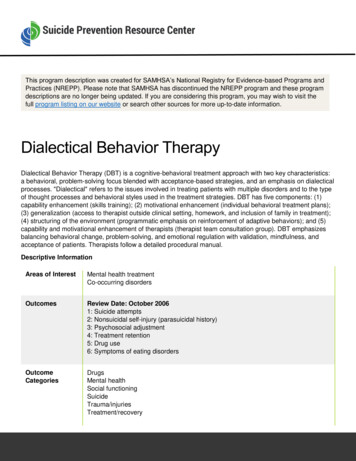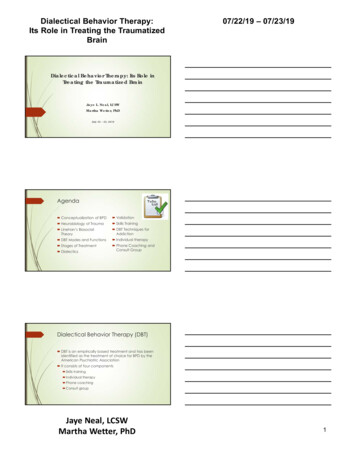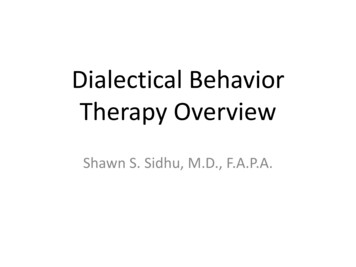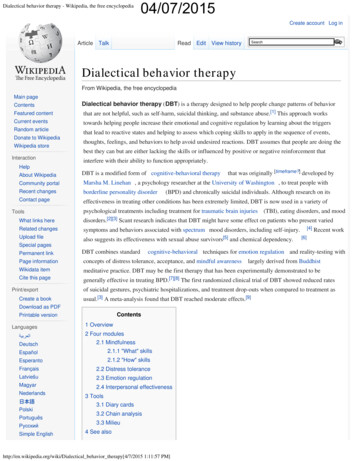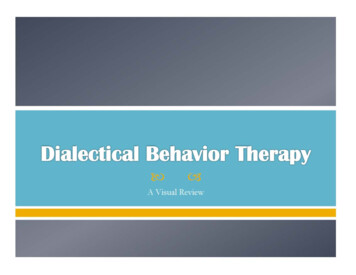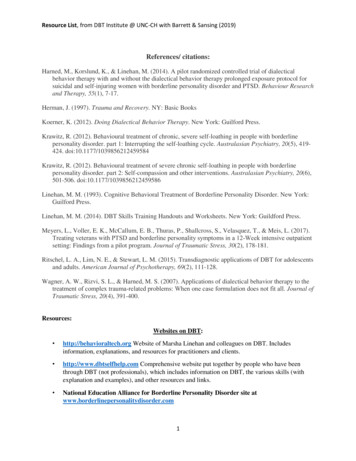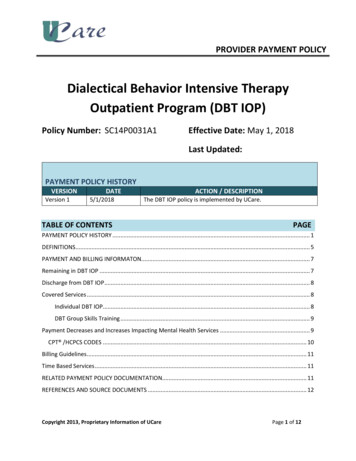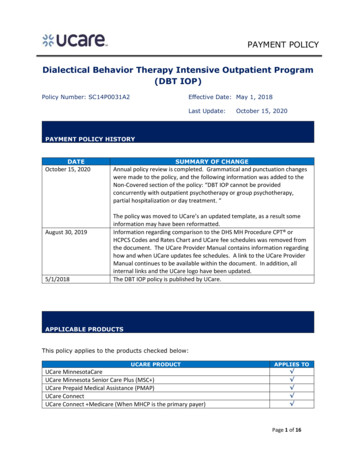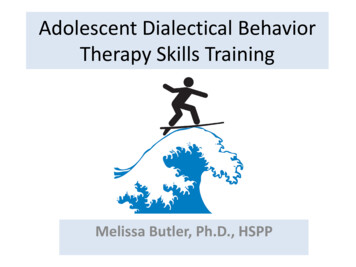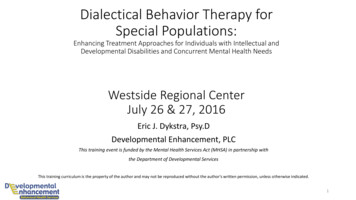
Transcription
Dialectical Behavior Therapy forSpecial Populations:Enhancing Treatment Approaches for Individuals with Intellectual andDevelopmental Disabilities and Concurrent Mental Health NeedsWestside Regional CenterJuly 26 & 27, 2016Eric J. Dykstra, Psy.DDevelopmental Enhancement, PLCThis training event is funded by the Mental Health Services Act (MHSA) in partnership withthe Department of Developmental ServicesThis training curriculum is the property of the author and may not be reproduced without the author's written permission, unless otherwise indicated.1
Developmental Enhancement Professionals with expertise in developmental and mental healthareas Assessment, Treatment, and Consultation Clinic-Based Private Practice Statewide Evaluation and Consultation Individuals, Families, Programs, Organizations7086 8th Ave.Jenison, MI 49428Phone: (616) 667-9551Fax: (616) p://www.thecenterforcd.com2
Treatment Resource Psychotherapy forIndividuals with IntellectualDisability. Available from NADD(www.thenadd.org)3
Dialectical Behavior Therapy:An Overview4
General Philosophy Worldview of Dialectics Functional Contextualism Developmental-Behavioral Perspective Working Assumptions The DBT Team5
Dialectical Worldview A “dialectic worldview” is a way of thinking that embraces a nonabsolute ‘truth’ model, allows for (seemingly) conflictingperspectives, and sees ‘truth’ as developing, evolving, andconstructed over time. This is middle ground between Universalism (ABSOLUTE TRUTH) andcomplete Relativism (NO TRUTH – ITS ALL RELATIVE)6
Dialectical Worldview This worldview advocates the use of words such as ‘AND’ instead of‘BUT’ or “NOT” and is intentionally inclusive in nature. Its about seeing the middle ground between seeing two seemingcontradictions.7
The “Dialectic” in DBT There are three primary characteristics of a dialectical worldview: The principle of wholeness and interrelatedness The principle of polarity The principle of continuous change (thesis, antithesis, and synthesis)8Linehan, 1993a
The “Dialectic” in DBT Practically, this approach seeks to balance acceptance (validation) and change. Recognizing the functionality of current behaviors and the inherent potentialfor growth in each client, the therapist works to facilitate change through skillbuilding and mindfulness training, as well as acceptance strategies.9
Foundations of DBT Philosophical Underpinnings Functional Contextualism (contemporary radical behaviorism)Philosophy of scienceundergirds behavior analysisWhole-person-in-context perspectiveInvolved in many contemporary approaches that utilize Acceptance and Mindfulnessstrategies10Linehan, 1993a; Koerner & Dimeff, 2007
Developmental-BehavioralPerspective DevelopmentalDevelopment as a lifelong processMany opportunities for disruption andremediationNeed for “redoing” and “relearning”Expectations based on whole-personfactors, not simply chronological ageor any other single factorBehavioral Principles of Learning(reinforcement, etc) Focus on act-in-situation Insight, Awareness,Understanding are fine, butdon’t necessarily cause changeto occur11
Foundations of DBT Bio-Psycho-Social Theory highly emotionally reactive to environments and problems returning to abaseline arousal level history of trauma and severe emotional dysregulation skills deficits that inhibit effective coping with such experiences results in crisis-ridden lives characterized by chaotic interpersonalrelationships and poor day-to-day functioningLinehan, 199312
Foundations:Bio-Psycho-Social Theory Application: the interplay between our biology, psychology, and socialexperiences (among other factors) is the foundation forunderstanding and working A WHOLE-PERSON, CONTEXTUAL, PERSON-CENTERED APPROACH13
Working Assumptions(taking a DBT stance) Clients are doing the best they canClients want to improveClients need to do better, try harder Clients have not caused all of their problems but they have to solve them anywayClients’ lives are unbearable as they currently areClients must learn new ways of being in all relevant situationsClients can not fail in treatmentTreators (everyone on the DBT Team) need assistance and support when workingwith individuals with intensive problems14
The DBT Team This means EVERYONE! Direct Care StaffAdministrative ManagersCase ManagementCliniciansNursingPsychiatristConsultants 15
The DBT Team:Client Focused Provide a safe, consistent, therapeutic environment Create a positive teaching milieu Develop a validating, accepting, change promoting culture16
The DBT Team:Team Focused Support & Encourage Teach & Learn Hold Accountable17
DBT Team Agreements Dialectical Agreement Consultation to the Patient Consistency Agreement Empathic Orientation Fallibility Agreement18
Clients and Selves Remember core assumptions: We are all doing the best we are able in this moment Things are okay the way they are (validation) and change can happen and willbe beneficial19
Moving from DBT to DBT-SP20
DBT-SP Methods Group Skills Training Individual Therapy Consultation/Supervision Research/Outcomes Evaluation21
Fidelity to the Model DBT and DBT-SP are organized in an intentional fashion The components are purposefully emphasized22
Why DBT-SP? Individuals with developmental disabilities suffer from the same difficulties in lifethat persons of average intelligence suffer from, such as grief, feelings ofdepression and anxiety, and so forth There is a clear need for innovative treatment approaches for people withintellectual disabilities Standard DBT can be difficult to comprehend for those with learning challenges,for kids/adolescents, and for those whose cognitive/intellectual skills are eventemporarily compromised23
Why DBT-SP? Some client characteristics include: Difficult to treat using typical “talk therapy”Difficulties with regulating emotionsHigh levels of interpersonal conflictHigh levels of impulsivityDisplay self injurious behavior at timesMultiple Diagnoses24
Why Should DBT-SP Work? Common characteristics between populations for which DBT has beenfound to work and people with developmental disabilities Higher incidence of trauma than the general populationImpaired impulse controlDifficulty identifying and managing frustration appropriatelyProblems with regulation of emotionLack of effective methods for self-soothing25
DBT-SP and Trauma Some people will be able to move quickly into the trauma work that isneeded Others may be experiencing significant dysregulation and unable tofunction well without fundamental skill training prior to traumabased therapy26
What About Self-Regulation? Areas Prone to Dysregulation: EmotionsOvert BehaviorsCognitive ActivitySleepBlood Pressure/Heart Rate27
Why Regulation Matters Emotions Mental Health: Mood Disorders, Anxiety Overt Behaviors ADHD, Aggression, Mania Cognitive Activity Executive Functions, Mood Disorders Blood Pressure/Heart Rate Hypertension, Coronary Disease, etc. Sleep All of the above28
Neurological Underpinnings You Name It – it’s involved Thalamus, Hypothalamus, Pituitary, Prefrontal Cortex, SuprachiasmaticNucleus, etc. Serotonin, Dopamine, Melatonin, etc. Autonomic Nervous System Sensory Systems29
DBT-SPGroup Skills TrainingNOTE: Handouts are modified with permission from Linehan 1993b30
Mindfulness What is Mindfulness? “Being in the moment” “Paying attention on purpose” “Mindful vs. Meditative” Why Mindfulness? How to be Mindful31
Mindfulness:Handout 1 States of Mind Thinking Hot vs. Thinking Cool Examples? Wise Mind The Middle Ground32
Mindfulness:Handout 2 Mindfulness: What To Do Observe Describe Participate33
Mindfulness:Handout 3 Mindfulness: How To Do It Accept One Thing Effectively34
Mindfulness Activities List of Ideas Others?35
Distress Tolerance Overview of Module Why Distress Tolerance? What is it all about?36
Distress Tolerance:Handouts 1 & 2 Teach Mindfulness Goals of DT Life happens, so Acceptance vs. The Struggle Understand, Accept, Survive37
Distress Tolerance Handout 2: Reasons to use skills Handout 3: Ways to survive Distract Calm Choices38
Distress Tolerance Handout 4: Distracting Wise Mind Accepts ActivitiesContributeCompareEmotions (opposite)Push AwayThoughtsSensations39
Distress Tolerance Handout 5: Ways to survive bad times Self-soothing with our senses SeeingHearingSmellingTastingTouching40
Distress Tolerance Handout 6: Thinking about your choices Remember to focus on cause-effect relationships Outcomes can be positive or negative Handout 7: Accepting Reality Radical Acceptance Turning Your Mind Willingness41
Distress Tolerance Handout 7: Accepting Reality Radical Acceptance Turning Your Mind Willingness Handout 8: Accepting Reality Breathing Handout 9: Accepting Reality Half-Smiling Handout 10: Accepting Reality Focusing42
Distress Tolerance Review of Basic Concepts Questions, Comments, Etc.43
Emotion Regulation Overview of Module Why Emotion Regulation? What is it all about?44
What Is Regulation Really?It DOES mean Influence Change Alter Shift DirectIt DOES NOT mean Control Get Rid Of Eliminate45
Development of Regulation Abilities Reliance on others Self Regulation External/Behavioral Internal, Private Concrete, Specific Flexible, Multiple, Broad Avoidance-based Approach-based Short term Long term (goal directed)46
Emotion Regulation:Overview The point is not to get rid of emotions Overview of Skills Identifying and Labeling EmotionsIdentifying ObstaclesReducing VulnerabilityIncreasing Positive Emotion EventsIncreasing MindfulnessTaking Opposite ActionApplying DT Techniques47
Emotion Regulation ER Handout 1: Goals of ER Understand Emotions Control Behavior (Make Choices) Stop Feeling Bad All The Time ER Handout 2: Lies and Truths Focus is on “myth-busting” emotion-related beliefs and establishing universaltruths about emotions48
Emotion Regulation ER Handout 3a: Unhealthy Model of Emotions Stuff Happens, I Feel, I React, More Stuff Happens ER Handout 3b: Healthy Model of Emotions Stuff Happens, I Feel and I Think, I Choose ER Handout 15: Homework Sheet49
Emotion Regulation ER Handouts 4-8: Feelings For Emotions (happy, sad, mad, scared,embarrassed) Increase client awareness and vocabulary Establish/Reinforce/Generalize concept of prompting events50
Emotion Regulation ER Handout 9: What Good Are Emotions? Emotions Communicate to Others Emotions Communicate to Ourselves Emotions Prepare for Action51
Emotion Regulation ER Handout 10: Keeping Control of Your Emotions SEEDS GROW Sickness needs treatmentEat rightExerciseDrugs are badSleep wellGROW every day52
Emotion Regulation ER Handout 11: Feel Better More Often Have Fun Short Term and Long Term Be Mindful ER Handouts 12 & 13: (101) Ways to Have Fun ER Handout 14: Change How You Feel “Cut the strings” of emotions by using “Opposite Action”53
Emotion Regulation Review of Basic Concepts Questions, Comments, Etc.54
Relationship Effectiveness(How To Make Relationships Work) Overview of RE Module55
Relationship Effectiveness RE Handout 1: Goals of RE Getting What You Want Getting or Keeping Good Relationships Improving Self-Respect RE Handout 2: Lies and Truths About Relationships Set the stage Have clients identify areas they are susceptible56
Relationship Effectiveness RE Handout 3: Making Choices Asking Saying No Practice these skills frequently have clients role play, give examples,etc.57
Relationship Effectiveness RE Handout 4: Making Choices – Things to Think About PrioritiesThe RelationshipRightsAuthorityRespectTimeAbility58
Relationship Effectiveness RE Handout 5: Why Use Skills? Taking Care of Relationships Balancing Wants and Shoulds Building Self-Respect RE Handout 6: Getting What You Want(DEAR MAN) DescribeExpressAsk/Say NoReward MindfulnessAppropriate BehaviorNegotiate59
Relationship Effectiveness RE Handout 7: RespectingYourself (FAST) FairApologiesSticking to what you believe inTell the truth RE Handout 8: Keeping GoodRelationships (GIFT) GentleInterestFunnyTry to Understand60
Relationship Effectiveness RE Handout 9: Sometimes Using Skills Is Hard Validate difficulties Emphasize need to keep trying RE Handout 10: Practicing RE Discuss other examples61
Relationship Effectiveness Review of Basic Concepts Questions, Comments, Etc.62
Groups and Group Dynamics63
Group Dynamics Groups as a Social Microcosm Here-And-Now Interactions Real-Time Problem Solving In-Vivo Relationship Building64
Therapist Tasks Setting the Stage– Group Topic(s)– Group Format– Group Size and Characteristics– Environmental Considerations– Group Rules– Group Contract65
Therapist Tasks Primary role: Create and Maintain Rules Norms Expectations Ensure Survival Police, Firefighter, EMT 66
Therapist Tasks Culture Building: Technical Expert the WHAT Model Setting Participant the HOW67
Discussion Nuts and Bolts Qualities/Roles of Leaders Icebreakers/Cohesion Exercises68
Ways to Develop Groups Check-ins Sentence Completion SuperpowersFavorite (games, animals, movies, etc.)Personal CharacteristicsI need/want Personal Bingo/Scavenger Hunt Have You Ever/Do You Have On and on and on 69
DBT-SPIndividual Therapy70
Individual Therapy Role of Therapist Role of Therapy Therapy vs. Skills Coaching71
Individual Therapy CBT-Rooted Skills-Based approach Solution focused Works to inhibit problematic, maladaptive behaviors Replaces them with skillful responding Role-plays, review homework & diary cards, etc.72
Individual Therapy:Hierarchy of Focus Decrease high risk behaviors (including suicidal behaviors). Decrease therapy interfering behaviors. Decrease behaviors that interfere with quality of life. Improve ability to maintain and generalize behavioral skills.73
DBT-SP Individual Therapy:Hierarchy of Targets with Traumatized IndividualsQuality OfLifeTrauma-FocusedTreatmentTherapy InterferingBehaviorHigh Risk Behavior74Reinforce,Maintain, andGeneralize Skills
High risk behavior Analyze stressors and use behavioral chains to problem-solveTeach coping skills and facilitate accesses to resourcesFacilitate use of skills and resourcesEnsure environmental characteristics are not working against reducing high riskbehaviors Achieve greater behavioral regulation75
Therapy interfering behaviors Establish and develop relationship Check for motivation for treatment Analyze behavioral chains and problem solve Double-check relationship Teach in-vivo relationship skills and give feedback(transference/countertransference?!?) Triple-check relationship76
Axis I issues Anxiety Mood disorders Grief, trauma Etc.77
Trauma-Focused Treatment Utilize acceptance and change based strategies to work throughtrauma Examples of trauma treatment models that fit: Trauma Focused Cognitive Behavior Therapy (TF-CBT; Cohen, Mannarino andDeblinger, 2006) Interactive-Behavioral Therapy (Razza & Tomasulo, 1994) Acceptance and Commitment Therapy for Trauma/PTSD (Follette & Pistorello,2007; Follette, Palm, & Hall, 2004) And others (c.f. Follette & Ruzek, 2007)78
Quality Of Life Generalize new skills Target specific areas one at a time Teach situation specific skills (refine discernment) Maintain motivation for new change/new way of being Generalize and sustain progress on Axis I issues Facilitate movement towards personally fulfilling/valued activities79
Individual Therapy:Tasks Therapists Address Expand client capabilities Motivate the client to engage in new behaviors Generalize the use of new behaviors Establish a treatment environment that reinforces progress Maintain capable and motivated therapists80
DBT Team Consultation This is a vital component to maintaining a healthy, effective team Typically structured Format includes practicing skills we teach, consulting on tough cases,and ongoing learning Very inclusive group – especially working with adolescents81
Self-Care, Burnout, and Caregiver Fatigue The Team is designed to promote self-care and prevent burnout Warning Signs: Difficulty with working assumptionsIncreased judgmentFeelings of dread, annoyance, or dismissivenessPoor self-management This can happen to all of us none of us are immune82
Self Management Controlling what you say, how you say it. Self-awareness of your natural responses to events(what pushes your buttons, what has little effect,etc.). Watch out for anger, fear, and pride-basedresponses. Self-Management requires conscious attempts tobecome more self aware of your reactions & thenchoose how to respond. Self Management is key to providing a safe, nurturing,therapeutic residential treatment environment83
Self Care Activities VacationSocial ActivitiesTeam SupportPleasure ReadingConsultation/SupervisionTrainingTaking BreaksSpending Time with Loved OnesExercisePlay SleepEating WellTake WalksGo to the BeachDiversify WorkArt and MusicSpiritual/Religious PracticePersonal TherapyMeditationJournaling84
Program FeedbackFeedback from clinicians about DBT-SP: Increased sense of competence Gave structure to treatment Content in manual was vital Felt less burned out Experienced real change with clients Consultation provided is very helpful Clinician productivity up Reduced crisis resource costs (time, money, etc)85
Transition:DBT-SP to Trauma to TF-CBT86
Dysregulation Behavioral, Emotional, Cognitive Are they really distinct? All characterized by Over-reactivity, Unpredictability, Instability Illustrations A great rollercoasterA broken thermostatWeatherBallast87
Emotional Dysregulation:Definitions Heightened intensity of emotions Poorer understanding of emotions Greater negativity to emotionalexperience Less ability to self soothe afternegative emotions (Mennin, Heimberg, Turk, & Fresco,2004) "The inability to engage in goaldirected behaviors whenexperiencing distress.“ "Lack of awareness, understanding,and acceptance of emotions." "An unwillingness to experienceemotional distress as part ofpursuing desired goals." "Lack of access to adaptivestrategies for modulating theintensity and/or duration ofemotional responses." (Gratz & Roemer, 2004)88
Trauma, Dysregulation,and Neurology The parts of the brain that are most involved in PTSD are theamygdala, hippocampus, medial front cortex, thalamus,hypothalamus and the hypothalamic-pituitary-adrenal axis. Along with these, chemicals in the brain such as noradreneline,dopamine, serotonin, the opiod systems, insulin, and cortisol all playcomplex roles in the PTSD symptom producing process.89(van der Kolk, McFarlane, Weisaeth, 2006)
Adapted Trauma TreatmentWork Group Subgroup for Deaf and Hard of Hearing Subgroup for Developmental Disabilities90
Experiences of People with DD/ID in theCommunity Higher rates of maltreatment than the general population. Perpetrators perceptions: Ideal victims Lack credibility Unable to report91
Vulnerabilities Higher level of assistance from caregivers For longer periods of time For invasive daily functions Higher level of stress on the family People are less able to meet parental expectationsCharlton, Kliethermes, Tallant, Taverne, & Tishelman (2004)92
Vulnerabilities Cognitive disability interferes with: The ability to predict high-risk situations Understand what is happening in an abusive situation Barriers to reporting: Mobility challenges Restricted ability to communicateCharlton, Kliethermes, Tallant, Taverne, & Tishelman (2004)93
Trauma? Broadly defined as any event or experience that: Significantly conflicts with/alters worldview Calls into question issues of safety Compromises trust with caregivers/authority94
Trauma May Take Many Forms Natural disasters Accidents Invasive medical procedures Physical abuse Emotional abuse Sexual abuse Refugee of war95
Normal Response to Trauma Loss of control during the event. After the event: Intrusion of material from the eventNumbingEmotional constrictionIntense efforts to control experiences that might elicit memoriesDissociative splitting off or aspects of the experienceHypervigilance (enhanced startle response and sleep distrubance)Shattered sense of safetyDisruption of self-identity96
Trauma Information It is important that normal trauma responses not be attributed to theperson’s developmental disability or pre-existing mental illness. People with developmental disabilities generally have the same typesof symptoms following trauma that anyone else would: sleepdisturbance, startle response, numbing, emotional constriction,disrupted sense of safety, shattered self-identity, etc. Trauma responses generally represent a change from the person’snormal level of functioning.97
Dialectical Behavior Therapy: An Overview 4 . General Philosophy Worldview of Dialectics Functional Contextualism Developmental-Behavioral Perspective Working Assumptions The DBT Team 5 . Dialectical Worldview A dialectic worldview is a way of thinking that embra
